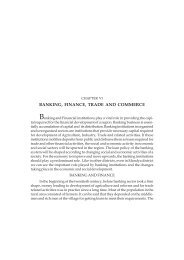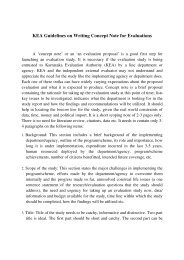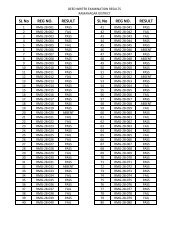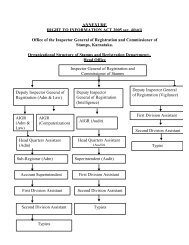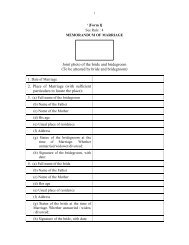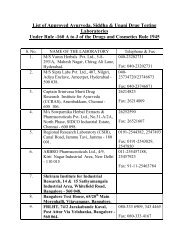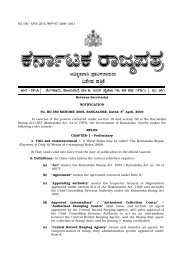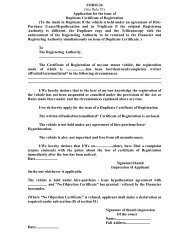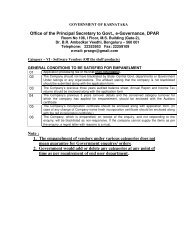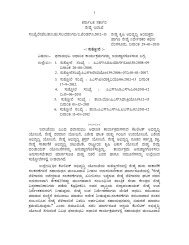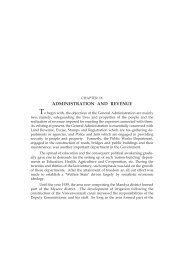Chapter XIII CULTURE - Government of Karnataka
Chapter XIII CULTURE - Government of Karnataka
Chapter XIII CULTURE - Government of Karnataka
You also want an ePaper? Increase the reach of your titles
YUMPU automatically turns print PDFs into web optimized ePapers that Google loves.
A Handbook <strong>of</strong> <strong>Karnataka</strong> 480<br />
acclaimed. Among the works <strong>of</strong> the thirties, D.V.Gundappa’s ‘Manku Thimmana<br />
Kagga’ stands out as a jewel. It is considered to be unique in the sense that it<br />
contains ethical principles, philosophic truths and experiences <strong>of</strong> life. Samsa<br />
wrote many plays in Halegannada, <strong>of</strong> which ‘Vigada Vikramaraya’ is the best<br />
example.<br />
It is interesting to note that except U.R.Ananthamurthy<br />
and Girish Karnad, all the five <strong>of</strong> the seven Jnanapeetah<br />
awardees in Kannada, Kuvempu, Da.Ra Bendre, Shivarama<br />
Karantha, Masthi Venkatesha lyengar and V.K.Gokak have<br />
been writing since the Navodaya period. Da.Ra. Bendre won<br />
the award primarily for ‘Naku Thanti’ a metaphysical poetic<br />
work but his popularity is based more on his writings drawn<br />
from folk culture. Shivarama Karantha’s writings range<br />
from encyclopedea to novels, essays, drama and poetry.<br />
‘Marali Mannige’ is his <strong>of</strong>t-mentioned novel, but ‘Bettada<br />
Jeeva’ ‘Chomana Dudi’ and ‘Mookajjiya Kanasugalu’ are<br />
also noteworthy. His works mirror the cultural ethos <strong>of</strong><br />
Dakshina Kannada. Masthi Venkatesha lyengar is primarily<br />
noted as short story writer, his ‘Chennabasava Nayaka’<br />
and ‘Chikaveerarajendra’ are historical novels dealing with<br />
degeneration <strong>of</strong> monarchy, and ‘Subbanna’ is a long story<br />
which reaches metaphysical heights. V.K. Gokak began as<br />
a Navodaya poet but his magnum opus is ‘Bharatha Sindhu<br />
Rashmi’ which seeks to find answers for the modern man’s<br />
dilemas in ancient epics. Significantly, Ananthamurthy’s<br />
‘Samskara’ ‘Bhava’ also seeks inspiration from traditional<br />
wisdom. Girish Karnad, Gesicaly pleys writer which are<br />
staged many times and translated to vanions Indian fourion<br />
langaugs.<br />
K.S. Narasimha Swamy’s ‘Mysoora Mallige’, a collection<br />
<strong>of</strong> poems with love and separation as the theme is a<br />
landmark <strong>of</strong> the Navodaya period. G.P. Rajarathnam’s<br />
‘Rathnana Padagalu’ perhaps stands unique in world<br />
literature in seeing truth a beauty in drunken man’s gay<br />
gibberish. Pu.Thi. Narasimhachar’s ‘Gokula Nirgamana’<br />
has Krishna’s separation from Radha as its theme.and this<br />
again reaches spiritual heights. Gorur Ramaswamy lyengar<br />
chose the easy form to portray the life <strong>of</strong> rural <strong>Karnataka</strong> his<br />
‘Halliya Chitragalu’ is considered the supreme example <strong>of</strong> his Jnanapeetah Awardees<br />
writings. His tradition was continued by A.N.Murthy Rao in ‘Hagaluganasugalu’<br />
and M.R.Srinivasa Murthy in ‘Rangannana Kanasina Dinagalu’.<br />
The period also saw a spurt <strong>of</strong> literary critisism. Of these T.N. Srikantaiya’s<br />
‘Bharathiya Kavya Meemamse’ is considered to be a classic. A.R. Krishna<br />
Shastry nurtured a whole generation <strong>of</strong> writers through ‘Prabuddha <strong>Karnataka</strong>’,



